AUDI A3 SEDAN 2018 Owners Manual
Manufacturer: AUDI, Model Year: 2018, Model line: A3 SEDAN, Model: AUDI A3 SEDAN 2018Pages: 404, PDF Size: 62.3 MB
Page 271 of 404
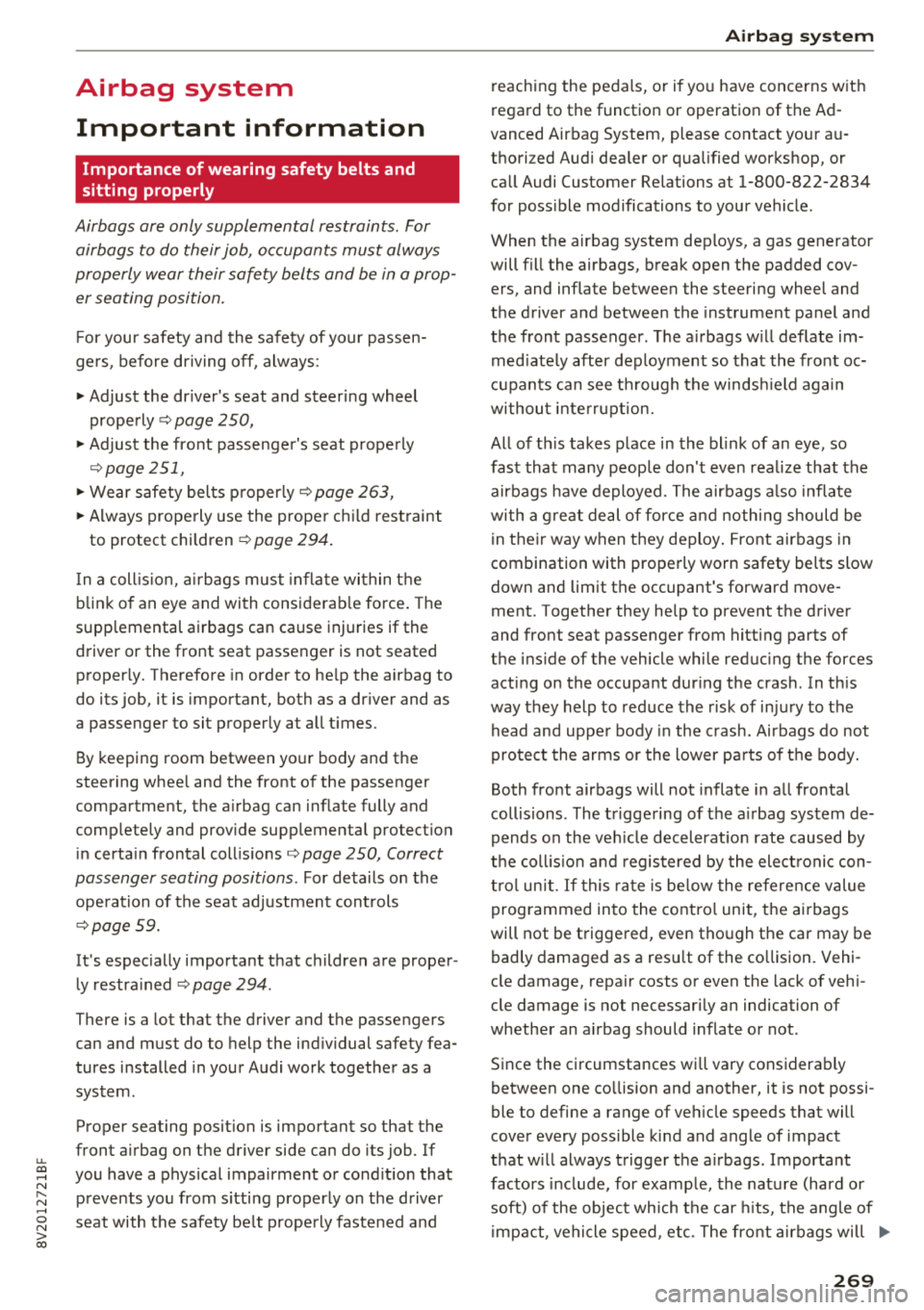
u. 00 .-< N l' N .-< 0 N > 00
Airbag system Important information
Importance of wearing safety belts and
sitting properly
Airbags are only supplemental restraints. For
airbags to do their job, occupants must always
properly wear their safety belts and be in a prop
er seating position.
For your safety and the safety of your passen
gers, before driving off, always :
.,. Adjust the driver's seat and steering wheel
properly~ page 250,
.,. Adjust the front passenger's seat properly
~page 251,
.,. Wear safety belts properly ~page 263,
.. Always properly use the proper child restraint
to protect children
r=> page 294.
In a collision, airbags must inflate within the
blink of an eye and with considerable force. The
supplemental airbags can cause injuries if the
driver or the front seat passenger is not seated
properly. Therefore in order to help the airbag to
do its job, it is important, both as a driver and as
a passenger to sit properly at all times .
By keeping room between your body and the
steering wheel and the front of the passenger
compartment, the airbag can inflate fully and
completely and provide supplemental protection in certain frontal collisions
r=> page 250, Correct
passenger seating positions .
For details on the
operation of the seat adjustment controls
r=>page 59.
It's especially important that children are proper
ly restrained
r::> page 294 .
There is a lot that the driver and the passengers
can and must do to help the individual safety fea
tures installed in your Audi work together as a
system .
Proper seating position is important so that the
front airbag on the driver side can do its job. If
you have a physical impairment or condition that prevents you from sitting properly on the driver
seat with the safety belt properly fastened and
Airbag system
reaching the pedals, or if you have concerns with
regard to the function or operation of the Ad
vanced Airbag System, please contact your au
thori zed Audi dealer or qualified workshop, or
call Audi Customer Relations at 1-800-822-2834
for possible modifications to your vehicle.
When the airbag system deploys, a gas generator
will fill the airbags, break open the padded cov ers, and inflate between the steering wheel and
the driver and between the instrument panel and
the front passenger. The airbags will deflate im
mediately after deployment so that the front oc
cupants can see through the windshield again
without interruption.
All of this takes place in the blink of an eye, so
fast that many people don't even realize that the
airbags have deployed. The airbags also inflate
with a great deal of force and nothing should be
in their way when they deploy. Front airbags in
combination with properly worn safety belts slow
down and limit the occupant's forward move
ment . Together they help to prevent the driver
and front seat passenger from hitting parts of
the inside of the vehicle while reducing the forces acting on the occupant during the crash . In this
way they help to reduce the risk of injury to the
head and upper body in the crash. Airbags do not
protect the arms or the lower parts of the body.
Both front airbags will not inflate in all frontal
collisions . The triggering of the airbag system de
pends on the vehicle deceleration rate caused by
the collision and registered by the electronic con
trol unit . If this rate is below the reference value
programmed into the control unit, the airbags
will not be triggered, even though the car may be badly damaged as a result of the collision. Vehi
cle damage, repair costs or even the lack of vehi
cle damage is not necessarily an indication of
whether an airbag should inflate or not .
Since the circumstances will vary considerably between one collision and another, it is not possi
ble to define a range of vehicle speeds that will
cover every possible kind and angle of impact
that will always trigger the airbags . Important
factors include, for example, the nature (hard or
soft) of the object which the car hits, the angle of
impact, vehicle speed , etc. The front airbags will
.,.
269
Page 272 of 404
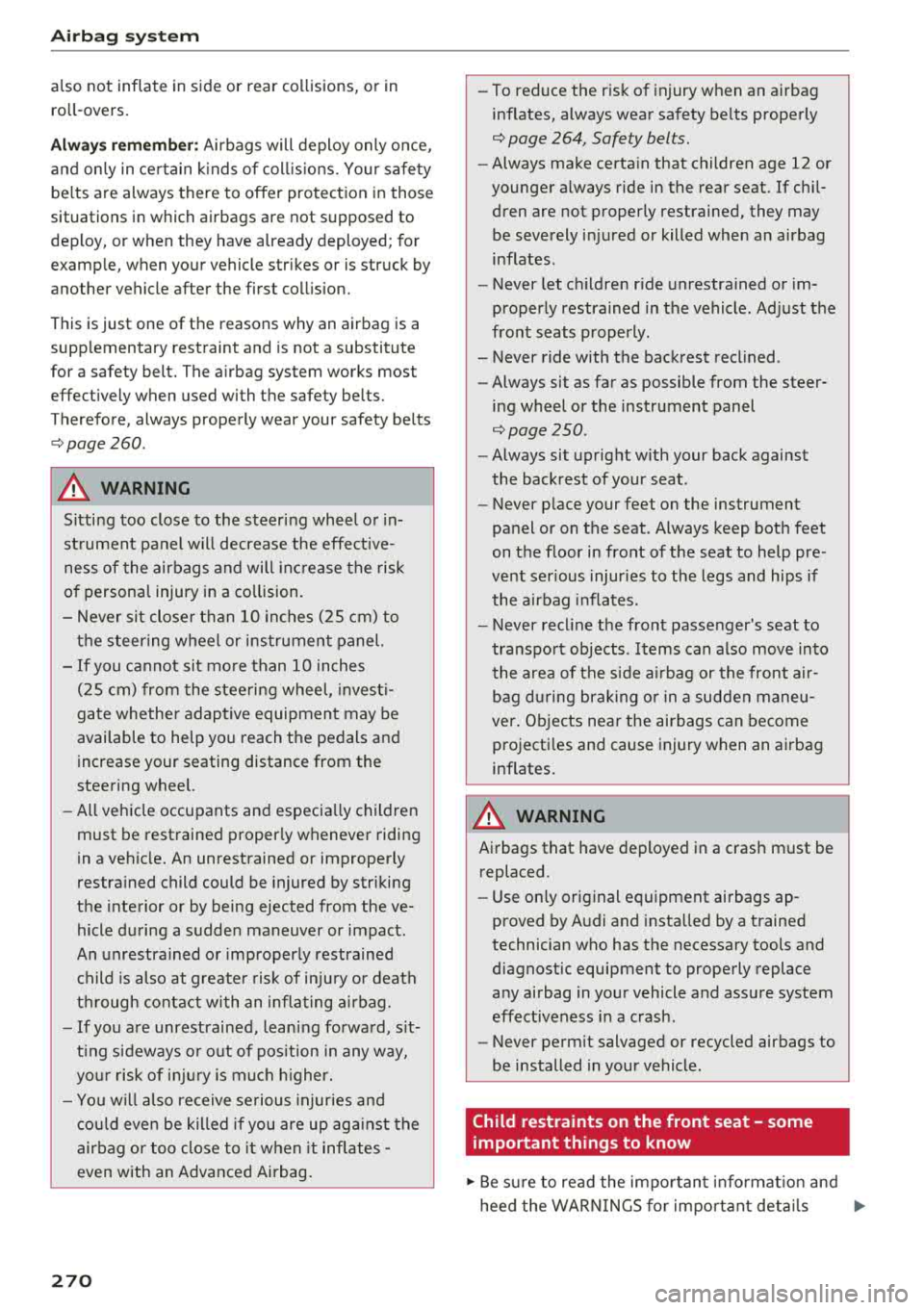
Airbag syste m
also not inflate in side or rear co llisions, or in
ro ll- overs.
Alwa ys rem ember : Airbags will deploy only once,
and on ly in ce rtain k inds of coll is ions. Yo ur safety
be lts are always there to offer protection in those
situations in which airbags are not supposed to
deploy, or when they have already deployed; for
examp le, when your vehicle str ikes or is struck by
another vehicle after the first collision.
This is just one of the reasons why an airbag is a
supplementary restraint and is not a substitute
for a safety belt. The a irbag system works most
effect ively when used with the safety belts.
Therefore, always properly wear your safety belts
r;:;, page 260 .
A WARNING
Sitting too close to the steering wheel o r in
st rument panel will decrease the effective
ness of the airbags and will inc rease the risk
of personal injury in a co llision.
- Never sit closer than 1 0 inches (25 cm) to
the steering wheel or instrument panel.
- If you cannot sit mo re than 10 inches
( 2 5 cm) from the steering wheel, invest i
gate whether adaptive equipment may be
available to help yo u reach the pedals and
increase your seating distance from the
steering wheel.
- All vehicle occupants and especially children
must be restrained properly whenever riding
in a vehicle. An unrestrained or improperly
restra ined child could be injured by striking
the interior or by being ejected from the ve
hicle during a sudden maneuver or impact.
An unrestrained or imp roperly restrained
child is also at greate r risk of inju ry or death
through contact with an infla ting airbag .
-If you are unrestrained, leaning fo rwa rd, s it
t ing s ideways or o ut o f pos ition in any way,
yo ur risk of in ju ry is much h igher.
- Yo u will also receive serious injuries and
could even be killed if you are up aga inst the
air bag or too close to it when it inflates -
even with an Advanced Airbag.
270
-
- To reduce the r is k of i njury when an a irbag
inflates, always wear safety belts prope rly
r;:;, page 264, Safety belts.
- Always make certa in that children age 12 or
younge r always ride in the rear seat. If chil
dren are not properly restrained, they may be severely injured or killed when an airbag
inflates.
- Never let ch ildren r ide unrestra ined or im
properly restrained in the vehicle . Ad just the
front seats properly .
- Never ride with the back rest recl ined .
- Always sit as far as possible from the steer-
ing wheel or the instrument panel
r;:;, page 250 .
-Always sit upright w ith your back against
the backrest of your seat .
- Never p lace your feet on the instrument
panel or on the seat . Always keep both feet
on the floor in front of the seat to help pre
vent serious injur ies to the legs and hips if
the airbag inflates.
- Never recl ine the front passenger's seat to
transpo rt objects . Items can also move into
the area of the s ide airbag or the front air
bag du ring brak ing o r in a sudden maneu
ver . Obje cts nea r the airbags can become
pro jecti les and cause injury when an airbag
inflates.
A WARNING
Airbags that have deployed in a crash m ust be
replaced.
- Use on ly original equipment airbags ap
proved by Audi and installed by a trained
technician who has the necessary tools and
diagnostic equipment to properly replace
any airbag in yo ur vehicle and assure system
effectiveness in a crash.
- Never perm it salvaged or recycled airbags to
be installed in your vehicle .
Child restraints on the front seat - some
important things to know
.,. Be s ure to re ad the impo rtan t in format ion an d
hee d the WARN IN GS for impo rt a nt deta ils
..,.
Page 273 of 404
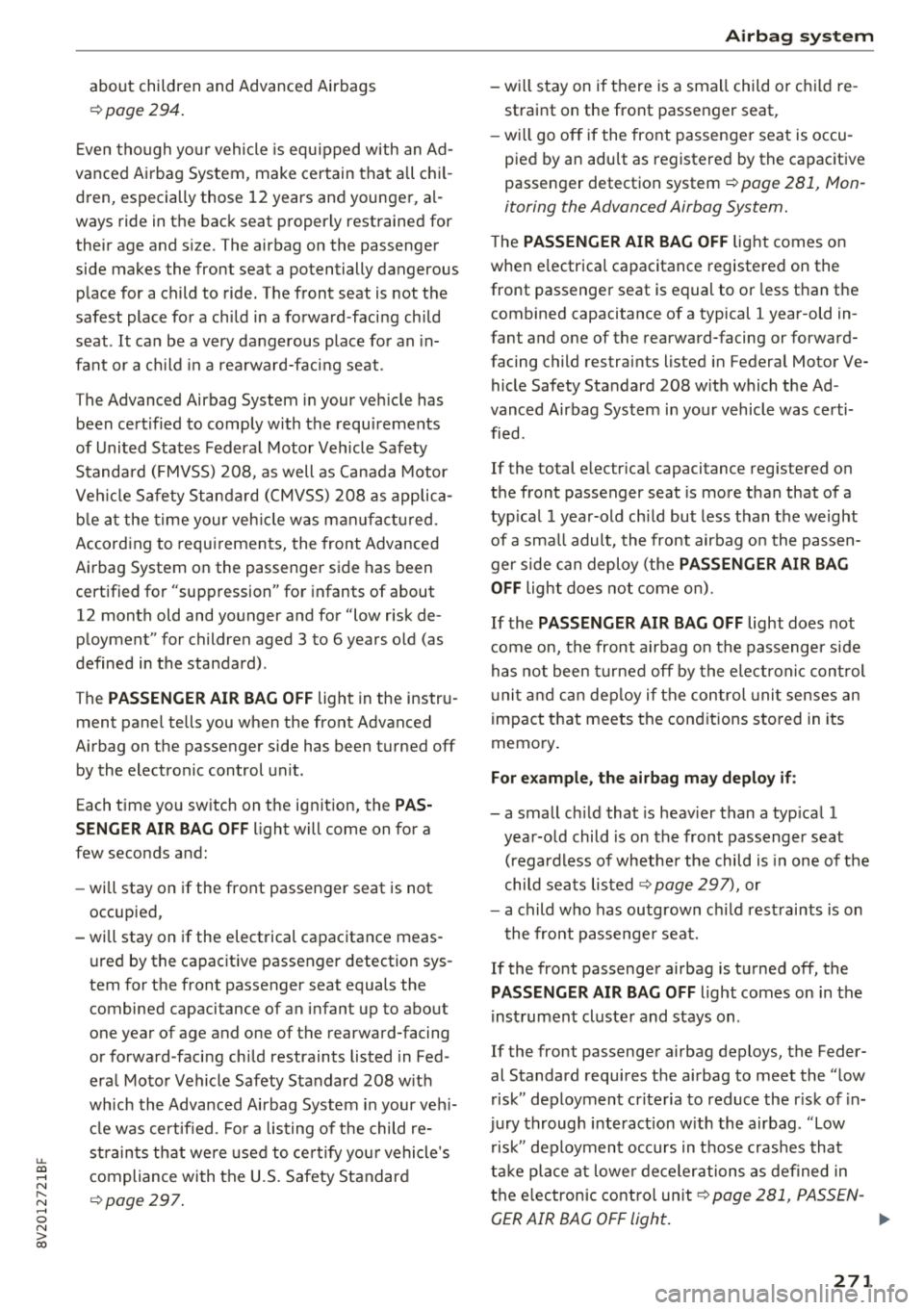
u. 00 .-< N l' N .-< 0 N > 00
about children and Advanced Airbags
~page 294 .
Even though yo ur vehicle is equ ipped with an Ad
vanced Airbag System, make certain that a ll chil
dren, especially those 12 years and younger, al
ways ride in the back seat proper ly restrained for
their age and size. The airbag on the passenger
side makes the front seat a potentially dangerous
place for a child to ride. The front seat is not the
safest place for a child in a forward-facing child
seat .
It can be a very dangerous place for an in
fant or a ch ild in a rea rward-fac ing seat.
The Advanced Airbag System i n your veh icle has
been certified to comply w ith the requ irements
of United States Federal Motor Vehicle Safety
Standa rd (FMVSS) 208, as well as Canada Motor
Ve hicle Safety Standa rd (CMVSS) 208 as applica
b le at the time your veh icle was man ufactu red.
According to requirements, the front Advanced
Airbag System on the passenger side has been
certified for "suppression" for infants of about 12 month old and younger and for "low risk de
p loyment" for children aged 3 to 6 years o ld (as
defined in the standard) .
T he
PASSENGER AIR BAG O FF light in the instru
ment panel tells you when the front Advanced
Airbag on the passenger side has been turned off by the electronic control unit .
Each time yo u switch on the ignition, the
PA S·
S ENGER AIR BAG OFF
light will come on for a
few seconds and:
- wi ll stay on if the front passenger seat is not
occupied,
- wi ll stay on if the electrical capacitance meas
ured by the capacitive passenger detection sys
tem for the front passenger seat equals the combined capacitance of an infant up to about
one year of age and one of the rearward-facing
or forward-facing child restraints listed in Fed
eral Moto r Vehicle Safety Standard 208 w it h
wh ich the Advanced Airbag System in your veh i
cle was cert ified . F o r a listing of the child re
straints that were used to ce rt ify you r vehicle 's
compliance with the U.S. Safety Standard
~ page 297 .
Airbag syste m
- wi ll stay on if there is a small child or child re
straint on the front passenger seat,
- wi ll go off if the front passenger seat is occu
pied by an adu lt as registered by the capacitive
passenger detection system
~ page 281, Mon
itoring the Advanced Airbag System.
T he PAS SEN GER AIR BAG OFF lig ht comes on
when e lectrica l capacitance registered on the
front passenger seat is equal to or less t han the
combined capacitance of a typical 1 year-old in
fant and one of the rearward-facing or forward
facing child restrai nts listed in Federal Motor Ve
hicle Safety Standard 208 w it h which the Ad
vanced Airbag System in your vehicle was ce rti
fied.
If the to tal electr ical capacitance reg istered o n
the front passenger seat is more than that of a
typ ical 1 year-old ch ild but less than the weight
of a sma ll adult, the front airbag on the passen
ger side can deploy (the
PASSENGER AIR BAG
OFF
light does not come on).
If the
PASSENGER AIR BAG OFF light does not
come on, the front airbag on the passenger s ide
has not been turned off by the electronic cont rol
u nit and can dep loy if the control unit senses an
impact t hat meets the conditions stored in its
memory.
For example , the airbag ma y deplo y if:
- a small ch ild that is heav ier than a typ ical 1
year-old child is on the front passenger seat (regardless of whethe r the child is in one of t he
child seats listed
~ page 297), or
- a child who has outgrown c hild rest raints is on
the front passenge r seat.
If the front passenger airbag is turned off, the
PASSENGER AIR BAG OFF light comes on in the
i nst rument cluste r and stays on .
If the front passenger airbag deploys, the Feder
al Standard requires the airbag to meet the "low
risk" deployment cr iteria to reduce the r isk of in
jury through interact ion w ith the airbag . "Low
r isk " deployment occurs in t hose crashes that
take place at lowe r decele rations as defined in
the e lectronic co ntrol
unit~ page 281, PASSEN -
GER AIR BAG OFF light.
...
271
Page 274 of 404
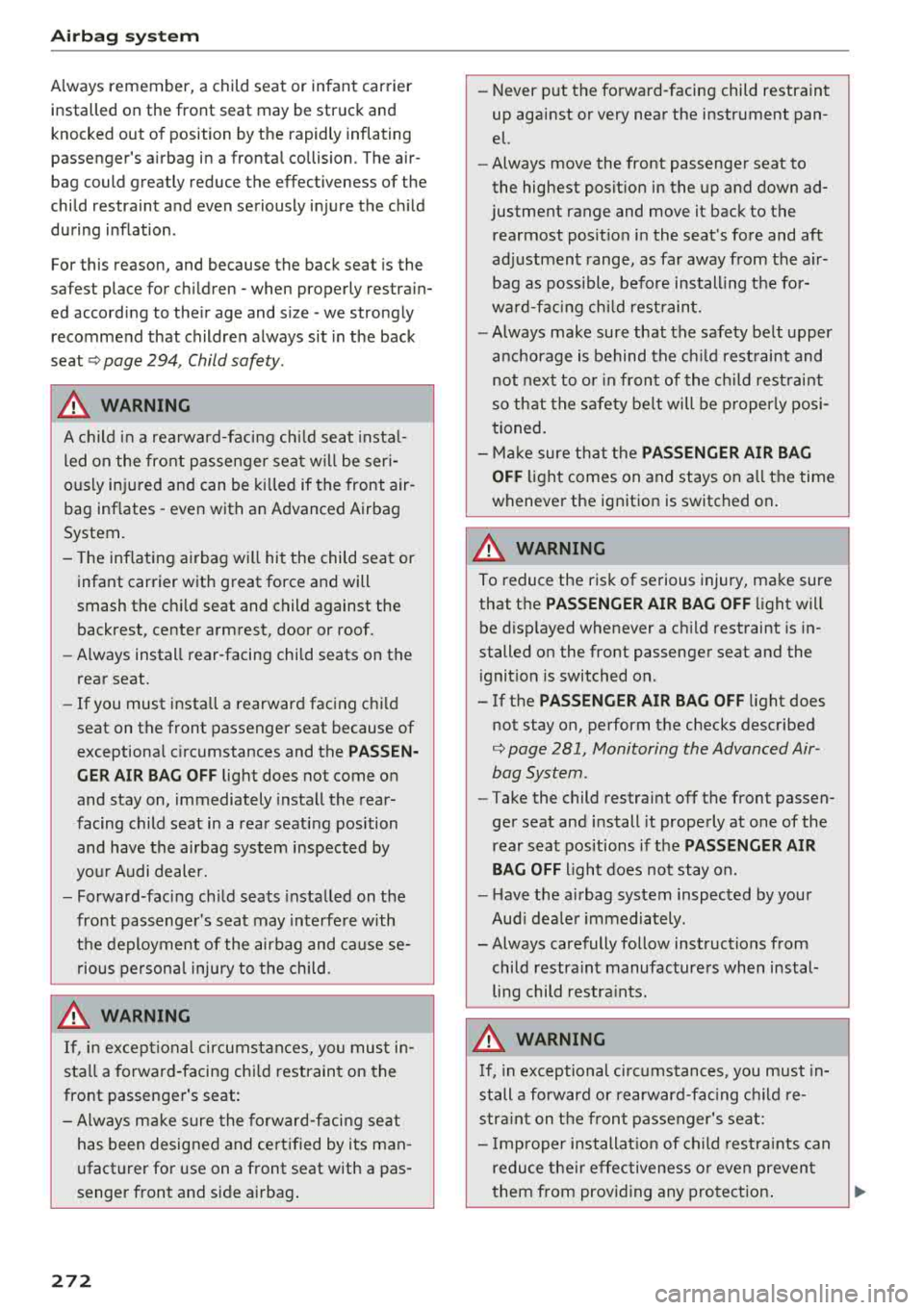
Airbag syste m
Always remember, a child seat or infant carrier
installed on the front seat may be struck and
knocked out of position by the rapidly inflating
passenger's airbag in a frontal collision. The air
bag could greatly reduce the effectiveness of the
child restraint and even seriously injure the ch ild
during inflation .
For this reason, and because the back seat is the
safest place for children
-when properly restra in
ed according to the ir age and size
-we strongly
recommend that children always sit in the back
seat ¢ page 294, Child safety.
.8, WARNING
A child in a rearward-facing chi ld seat insta l
led on the front passenger seat will be ser i
ously injured and can be killed if the front air
bag inflates
-even with an Advanced Airbag
System.
- The inflating a irbag w ill hit the child seat or
infant carrier with great force and will
smash the chi ld seat and child against the
backrest, center armrest, door or roof.
- Always install rear-facing child
seats on the
rear seat.
- If you must install a rearward facing chi ld
seat on the front passenger seat because of
exceptional c ircumstances and the
PASSEN
GER AIR BAG OFF
light does not come on
and stay on, immediately insta ll the rear
facing child seat in a rear seating position
and have the airbag system inspected by
yo ur Audi dealer.
- Forward-facing ch ild seats insta lled on the
front passenge r's seat may interfe re with
the deployment of the airbag and cause se
rious persona l injury to the child.
.8, WARNING
If, in except ional circumst ances, you must in
stall a forward-facing chi ld restraint on the
front passenger's seat:
- Always make sure the forward-facing se at
has been designed and ce rt ified by its man
ufact urer for use on a front seat with a pas
senger front and side a irbag .
272
-
- Never put the fo rwa rd-facing child restraint
up against or very near the instrument pan
el.
- Always move the front passenge r seat to
the highest posit ion in the up and down ad
justment range and move it back to the
rearmost posit ion in the seat's fo re and aft
ad justmen t range, as far away from the a ir
bag as poss ible, before installing the for
ward-f acing chi ld restrain t.
- Always make sure that the safety be lt upper
anchorage is behind the ch ild rest raint and
not next to o r in fron t of the child rest raint
so th at the s afety be lt will be p roperly posi
tioned.
- Ma ke sure th at the
PASSENGER AIR BAG
OFF
light comes on and stays on a ll the time
wheneve r the ignit ion is switched on .
.8, WARNING
To reduce the risk of serious injury, ma ke sure
that the
PASSENGER AIR BAG OFF light will
be d isp layed whenever a ch ild rest raint is in
stalled on the front passenge r seat and the
ignition is switched on.
- If the
PASSENGER AIR BAG OFF light does
not stay on, perform the checks described
¢ page 281 , Monitoring the Advanced Air
bag System.
- Take the child restra int off the front passen
ge r seat and install it properly at one of the
rear sea t positions if the
PASSENGER AIR
BAG OFF
light does not stay on.
- Have the ai rbag system inspec ted by your
Aud i dea le r i mmediately.
- Always carefully follow ins tructions from
child restraint manufacture rs when instal
ling child restra ints .
.8, WARNING
I f, in exceptional ci rcumstances, you must in
stall a forward or rearward-fa cing child re
str aint on the fron t passenger's seat:
- Improper installat ion of child res traints can
redu ce the ir effectiveness or even preven t
them from provid ing any pro te ct ion .
Page 275 of 404
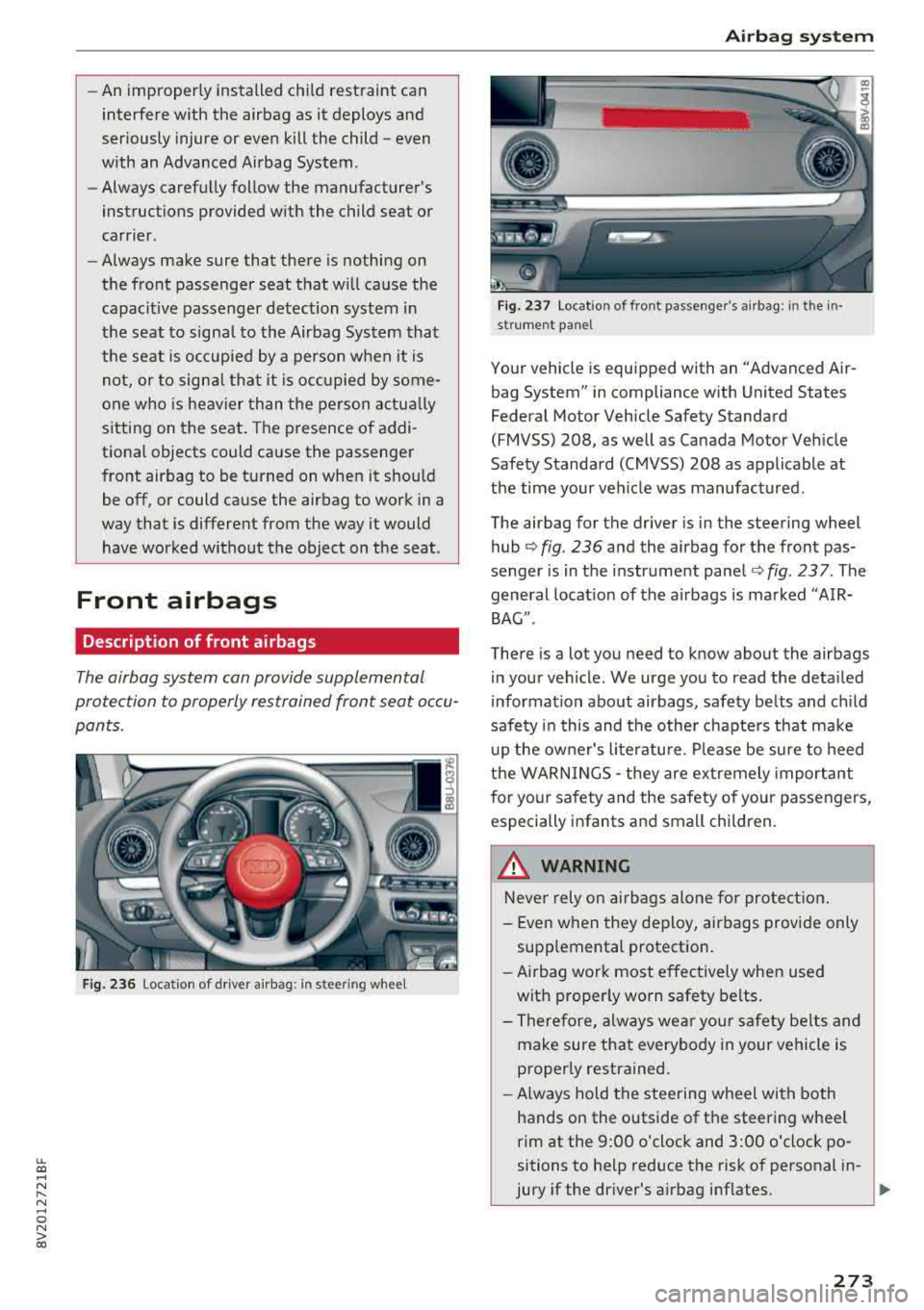
LL co ..... N
" N ..... 0 N > co
-An improper ly installed child restraint can
interfere with the airbag as it deploys and
seriously injure or even kill the child
-even
with an Advanced Airbag System.
- Always carefully follow the manufacturer's
instructions provided with the child seat or
carrier .
- Always make sure that there is nothing on
the front passenger seat that will cause the capacit ive passenger detection system in
the seat to signal to the Airbag System that
the seat is occupied by a person when it is
not, or to signal that it is occupied by some
one who is heavier than the person actually
sitting on the seat. The presence of addi
tional objects could cause the passenger
front airbag to be turned on when it should be off, or could cause the airbag to work in a
way that is different from the way it would have worked without the object on the seat .
Front airbags
Description of front airbags
The airbag system can provide supplemental
protection to properly restrained front seat occu
pants.
Fig. 236 Loc ation of driver a irbag: in ste .e ring wheel
Airbag system
Fig. 237 Location of front passenger's airbag: in the in
st rum ent panel
Your vehicle is equipped with an "Advanced Air
bag System" in compliance with United States
Federal Motor Vehicle Safety Standard
(FMVSS) 208, as well as Canada Motor Vehicle
Safety Standard (CMVSS) 208 as applicable at
the time your veh icle was manufactured.
The airbag for the driver is in the steering wheel
hub
¢ fig. 236 and the airbag for the front pas
senger is in the instrument panel
¢fig . 237. The
general location of the airbags is marked "AIR
BAG ".
There is a lot you need to know about the airbags
in your vehicle . We urge you to read the detailed
information about airbags, safety belts and child
safety in this and the other chapters that make
up the owner's literature. Please be sure to heed
the WARNINGS
-they are extremely important
for your safety and the safety of your passengers,
especially infants and small children.
_& WARNING
-Never rely on airbags alone for protection .
- Even when they deploy, airbags provide only
supplemental protection.
- Airbag work most effectively when used
with properly worn safety belts.
- Therefore, always wear your safety belts and
make sure that everybody in your vehicle is
properly restrained.
- Always hold the steering wheel with both
hands on the outside of the steering wheel
rim at the 9:00 o'clock and 3:00 o'clock po
sitions to help reduce the risk of personal in-
jury if the driver's airbag inflates.
..,.
273
Page 276 of 404
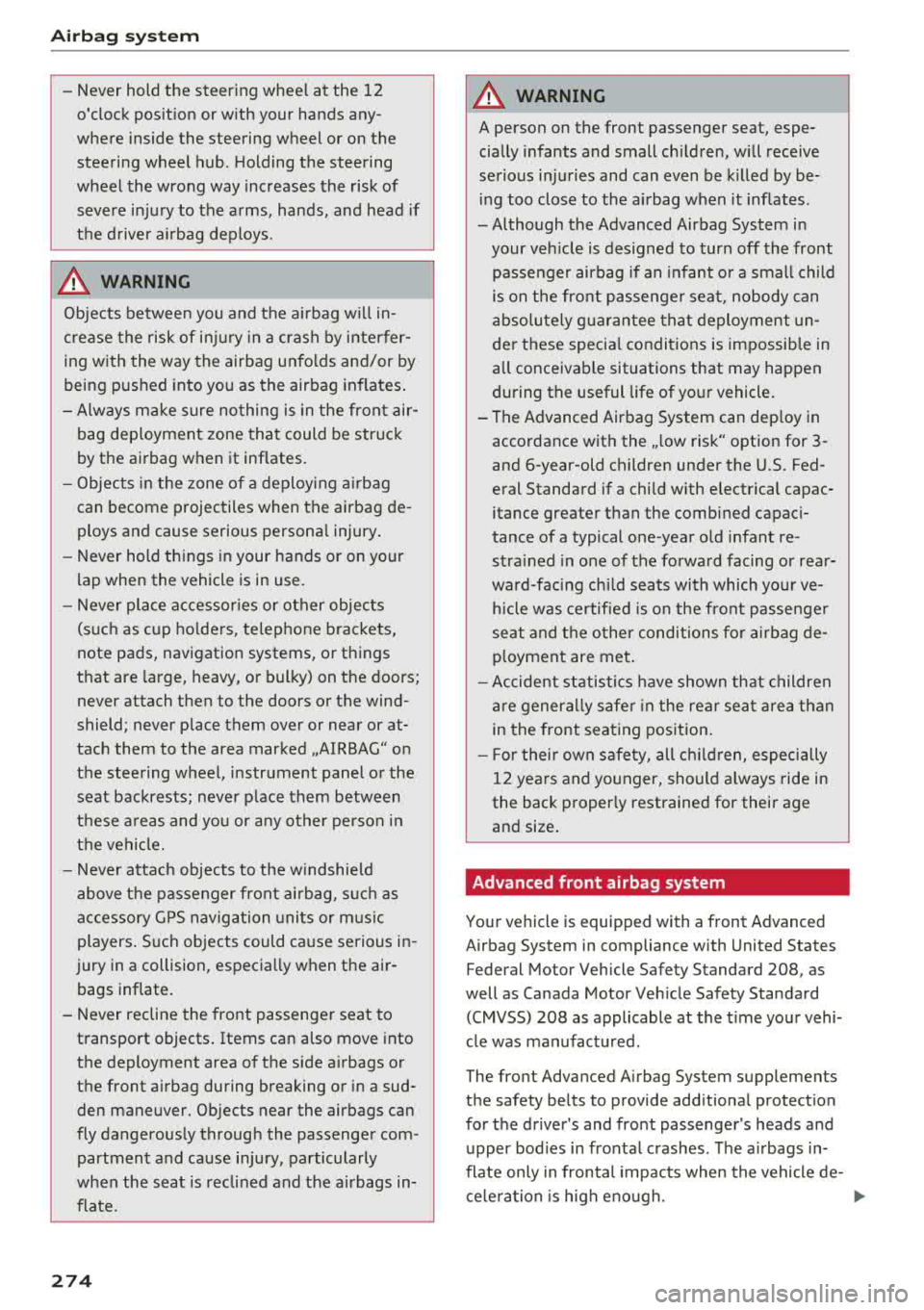
Airbag syste m
-Never hold the steering whee l at the 12
o'clock pos it ion or w ith your han ds any
where inside the steering wheel or on the steering wheel hub. Holding t he steering
wheel the wrong way increases the risk of severe injury to the arms, hands, and head if
the d river a irbag deploys.
A WARNING
Objects between you and the a irbag w il l in
crease the risk of inj ury in a crash by interfer
ing w ith the way the airbag unfo lds and/or by
being pushed into you as the airbag inflates .
- Always make sure nothing is in the front air-
bag deployment zone that could be str uck
by the airbag when it inflates.
-
- Objects in the zone of a deploying airbag
can become projectiles when the airbag de
ploys and cause serious persona l injury .
- Never hold th ings in your hands or on your
lap when the vehicle is in use.
- Never place accessor ies or other objec ts
(s uch as c up ho lders, telephone brackets,
note pads, navigation systems, or things
that are large, heavy, o r bulky) on the doors;
never attach then to the doors or the wind
shield; never place them over or near or at
tach them to the area marked
,,AIRBAG" on
the steering wheel, instrument panel or the seat backrests; never p lace them between
these a reas and yo u or any other person in
the vehicle.
- Never attach objects to the w indshield
above the passenger front airbag, s uch as
accessory GPS navigation uni ts or mus ic
players . S uch objects could ca use serio us in
jury in a collision, especially when the air bags inflate.
- Never recline the front passenger seat to transport objects . Items can also move into
the deployment area of the side a irbags or
the front a irbag during breaking o r in a sud
den maneuver. Objects near the airbags can
fly dangerous ly through the passenger com
partment and cause injury, particularly
when the seat is reclined and the airbags in
flate.
274
A WARNING
A person on the front passenger seat, espe
cially infants and small ch ildren, wi ll receive
serious in juries and can even be k illed by be
ing too close to the airbag when it inflates .
- Although the Advanced Airbag System in your veh icle is designed to turn off the front
passenger airbag if an infant o r a small child
is on the fron t passenger sea t, nobody can
absolu tely guarantee tha t deployment un
de r these specia l condi tions is impossible in
all conceivable situations that may happen
during the useful life of yo ur vehicle.
- The Advanced Airbag System can dep loy in
accordance with the
,. low risk" option for 3-
and 6-year-old children under the U.S. Fed
eral Standard if a child w ith electrical capac
itance greater than the combined capac i
tance of a typical one-year o ld infant re
strained in one of the forward facing or rea r
ward-facing chi ld seats with which yo ur ve
hicle was certified is on the front passenger
seat and the o ther conditions for airbag de-
ployment are me t.
- Accident s tatisti cs have shown th at children
are generally safer in the rear seat are a than
in the front seat ing pos ition.
- For their own s afety, all ch ildren, especi ally
12 years and younger, should alw ays ride in
the back proper ly restrained for their age
and size .
Advanced front airbag system
-
Your vehicle is equipped with a front Advanced
Airbag System in compliance with United States
Federal Motor Vehicle Safety Standard 208, as
well as Canada Motor Veh icle Safety Standard
(CMVSS) 208 as applicable at the t ime your vehi
cle was manufactu red .
The front Advanced A irbag System supplements
the safety belts to provide add itiona l protect ion
for the driver 's and front passenger's heads and
upper bod ies in fronta l crashes. The a irbags in
flate only in frontal impacts when the vehicle de-
ce le ra tion is high e no ugh.
II>-
Page 277 of 404
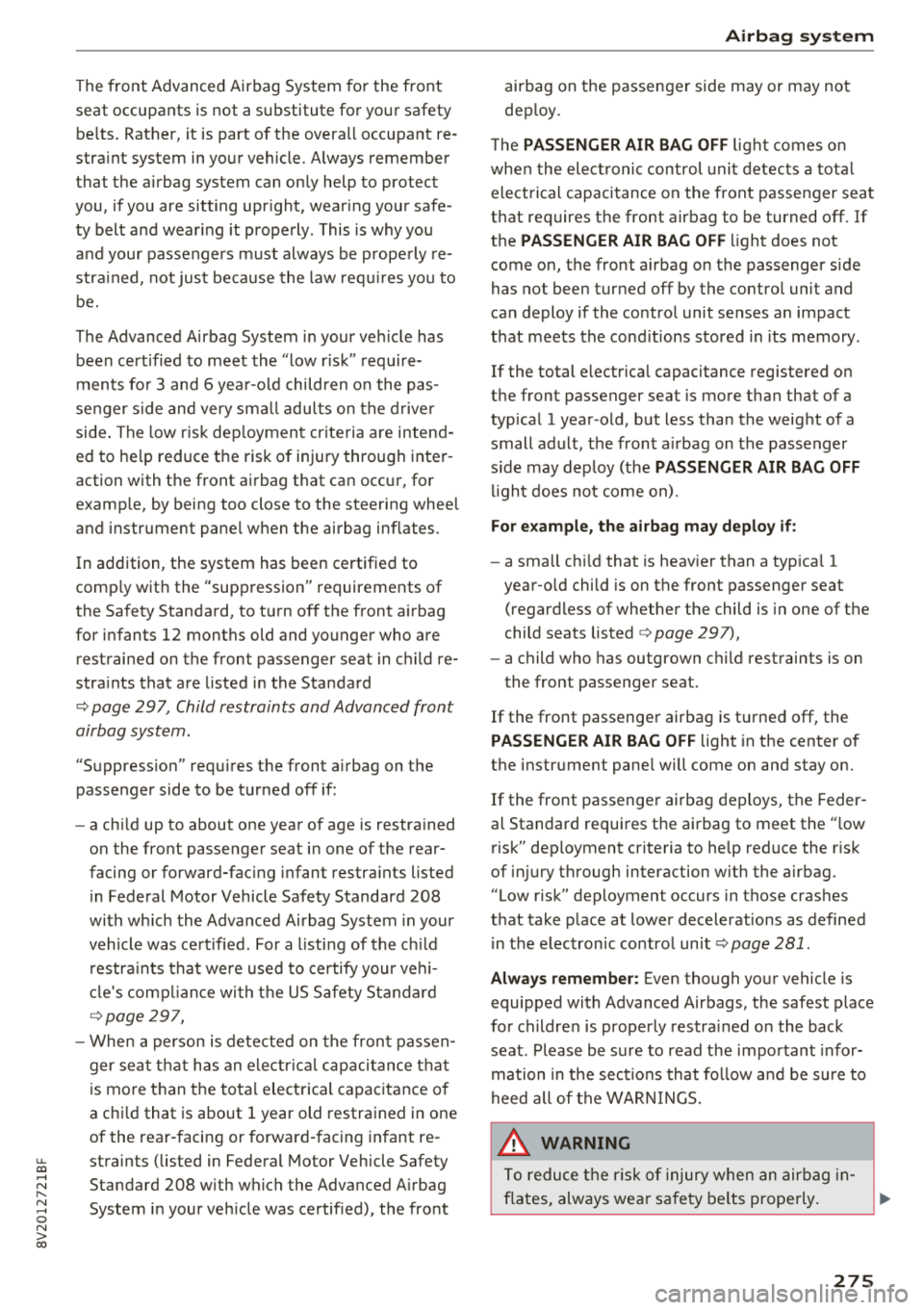
u. 00 .-< N l' N .-< 0 N > 00
The front Advanced Airbag System for the front
seat occupants is not a substitute for your safety
be lts. Rather, it is part of the overa ll occupant re
stra int system in your vehicle. A lways remember
that the airbag system can on ly help to protect
you, if you are sitting upr ight, wear ing your safe
ty belt and wear ing it properly . This is why you
and your passengers must always be prope rly re
stra ined, not just beca use the law req uir es yo u to
be.
The Advanced Airbag System in your ve hicle has
been ce rt ified to meet the " low r isk" requ ire
ments fo r 3 and 6 yea r-o ld children o n the pas
senger side and very sma ll adul ts on the d rive r
side . The low r is k dep loymen t cr iteria are intend
ed to he lp reduce t he ris k of injury through inter
action with the front airbag that can occ ur, for
examp le, by being too close to the steering whee l
and instrument pane l when the airbag inflates .
I n addition, the system has been certified to
comp ly with the "suppression" requirements of
the Safety Standard, to t urn off the front a irbag
for infants 12 months old and younger who are
restrained on the front passenger seat in c hild re
stra ints that are listed in the Standard
<=:> page 297, Child restraints and Advanced front
airbag system.
"Suppress ion" requ ires the front a irbag on the
passenger side to be turned
off if:
- a ch ild up to about one year of age is restra ined
on the front passenger seat in one of the rear
facing or forward-fac ing infant restra ints listed
in Federal Motor Vehicle Safety Standard 208
with wh ic h the Advanced Airbag System in your
vehicle was ce rt ified. For a listing of the c hild
r estra in ts tha t were used to certify your ve hi
cl e's comp lian ce wi th t he US S afety St andard
<=:> page 29 7,
- When a person is de te cte d on the fron t passen
ger sea t th at has an electr ica l capaci tance t hat
is mo re t han t he tota l electrical capac itance of
a chi ld that is about 1 year old restrained in one
of the rea r-facing or forward-facing infant re
straints (listed in Federal Motor Vehicle Safety Standard 208 w ith which the Advanced A irbag
System in your ve hicle was certified), the front
Airbag syste m
airbag on the passenger side may or may not
dep loy.
T he
PASSENGER AIR BAG OFF lig ht comes o n
whe n the elect ronic con trol uni t detec ts a t otal
electrica l capacitance on the front passenger seat
t h at requires the front airbag to be turned
off . If
t h e
PASSENGER AIR BAG OFF light does not
come on, the front airbag on the passenger side
has not been turned
off by the contro l unit and
can deploy if the contro l unit senses a n impact
t h at meets the cond it ions stored in its memory .
If the total electr ica l capacitance reg istered o n
the front passenger seat is more t han that of a
typ ical 1 year-old , but less than the weight of a
small ad ult, the front a irbag on the passenger
s ide may dep loy (the
PASSENGER AIR BAG OFF
li ght does not come on) .
For example, the airbag may deploy if :
-a small ch ild that is heav ier than a typ ica l 1
year-o ld child is on the front passenger seat
(regardless of whether the child is in one of the
child seats listed
¢ page 297),
- a child who has outgrown c hild rest raints is on
the front passenger seat.
If the front passenge r ai rbag is t urned off, the
PASSENGER AIR BAG OFF light in the center of
the instr ument pane l will come on and stay on.
If the front passenge r airbag deploys, the Feder
al Standard requi res t he airbag to meet the " low
risk" deployment criteria to he lp reduce the r is k
of i njury through interaction with the a irbag.
"Low risk" deployment occurs in those crashes
t h at take place at lower decelerations as defined
i n t he electron ic co ntro l
unit ¢ page 281 .
Always remember : Even though your vehicle is
equipped with Advanced Airbags, the safest place
for ch ildre n is properly restra ined o n the back
seat . Please be s ure to read the impo rtant in for
mation in the sect ions that fo llow a nd be sure to
heed all of the WAR NIN GS.
_&. WARNING
To redu ce th e r is k of injury when an air bag in -
fl ates, always wea r sa fe ty be lts properly .
...,
275
Page 278 of 404
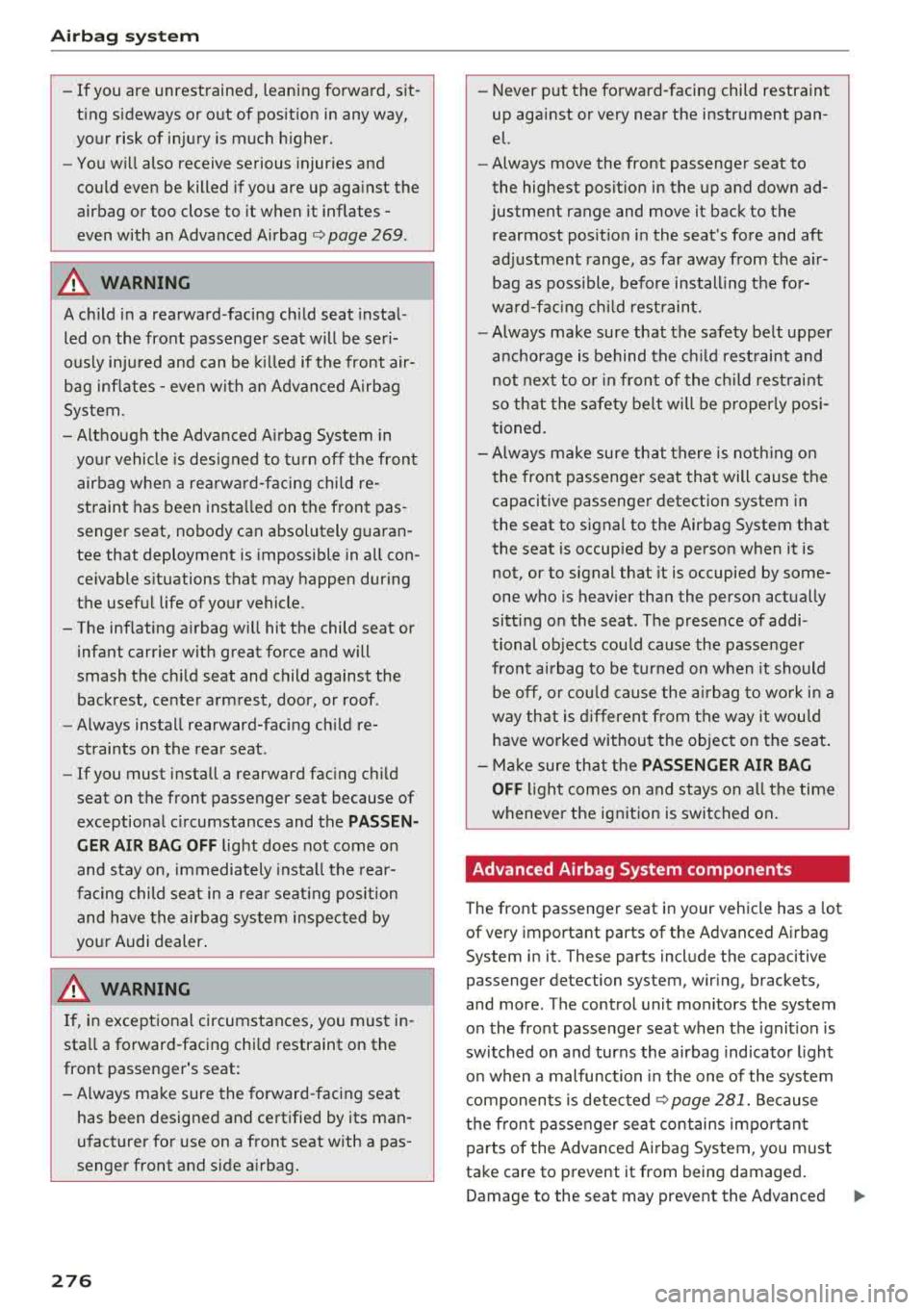
Airbag syste m
-If you are unrestrained, leaning forward, sit
t ing s ideways or out of pos ition in any way,
your risk of injury is much h igher.
- You will also receive serious injuries and
could even be killed if you are up aga inst the
airbag or too close to it when it inflates -
even with an Advanced
Airbag ¢ page 269.
A WARNING
A child in a rearward -facing child seat instal
led on the front passenger seat will be ser i
ously inju red and can be killed if the front air
bag inflates - even with an Advanced Airbag
System.
- Although the Advanced A irbag System in
yo ur vehicle is designed to tu rn off the front
airbag when a rearward-facing child re
straint has been insta lled on the front pas
senger seat, nobody can absolutely g uaran
tee that deployment is impossible in all con ceivable s ituations that may happen during
the useful life of your vehicle.
- The inflating airbag will hit the child seat or infant carrier w ith great force and will
smash the ch ild seat and child against the
backrest, center armrest, door, or roof .
- Always install rearward-facing ch ild re
straints on the rear seat .
- If you must install a rearward fac ing ch ild
seat on the front passenger seat because of
exceptional c ircumstances and the
PA SSEN
GER AIR BAG OFF
light does not come on
and stay on, immediately insta ll the rear
facing child seat in a rea r seating position
and have the airb ag system inspected by
yo ur Audi dealer .
A WARNING
If, in exceptional circumstances, you must in
stall a forward-facing chi ld restraint on the
front passenger's seat :
- Always make sure the forward -facing seat
has been designed and certified by its man
ufacturer for use on a front seat with a pas
senger front and side a irbag.
276
-
- Never put the fo rward-facing child restraint
up against or very near the instrument pan
el.
- Always move the front passenger seat to
the highest posit ion in the up and down ad
justment range and move it back to the rearmost posit ion in the seat's fore and aft
ad justment range, as far away from the a ir
bag as poss ible, before installing the for
ward-f acing chi ld restrain t.
- Always make sure that the safety be lt upper
anchorage is behind the ch ild rest raint and
not next to o r in fron t of the child rest raint
so th at the s afety be lt will be p roperly posi
tioned.
- Always make sure th at there is noth ing on
the front passenger seat that will cause the
capacitive passenger detection system in
the seat to signal to the Airbag System that
the seat is occup ied by a person when it is
not, or to signal that it is occupied by some
one who is heavier than the person actually
sitt ing on the seat . The presence of addi
tional objects could cause the passenger
front airbag to be turned on when it should
be off, or could cause the airbag to work in a
way th at is differen t from the w ay it wou ld
have worked without the objec t on the seat .
- Ma ke sure th at the
PASSENGER AIR BAG
OFF
li ght comes on and stays on all the time
whenever the ignition is switched on .
Advanced Airbag System components
The front passenger seat in your vehicle has a lot
of very important parts of the Advanced Airbag
System in it. These pa rts include the capacitive
passenger detection system, wir ing, brackets,
and more . T he control unit monitors the system
o n the front passenger seat when the ignit ion is
switched on a nd turns the airbag indicato r light
o n when a malfunction in the one of the system
components is
detected ¢ page 281. Because
t h e fron t passenger sea t contains impo rtan t
parts of the Advanced Ai rbag System , you must
take care to prevent it from being damaged .
Damage to the seat may prevent the Advanced
.,.
Page 279 of 404
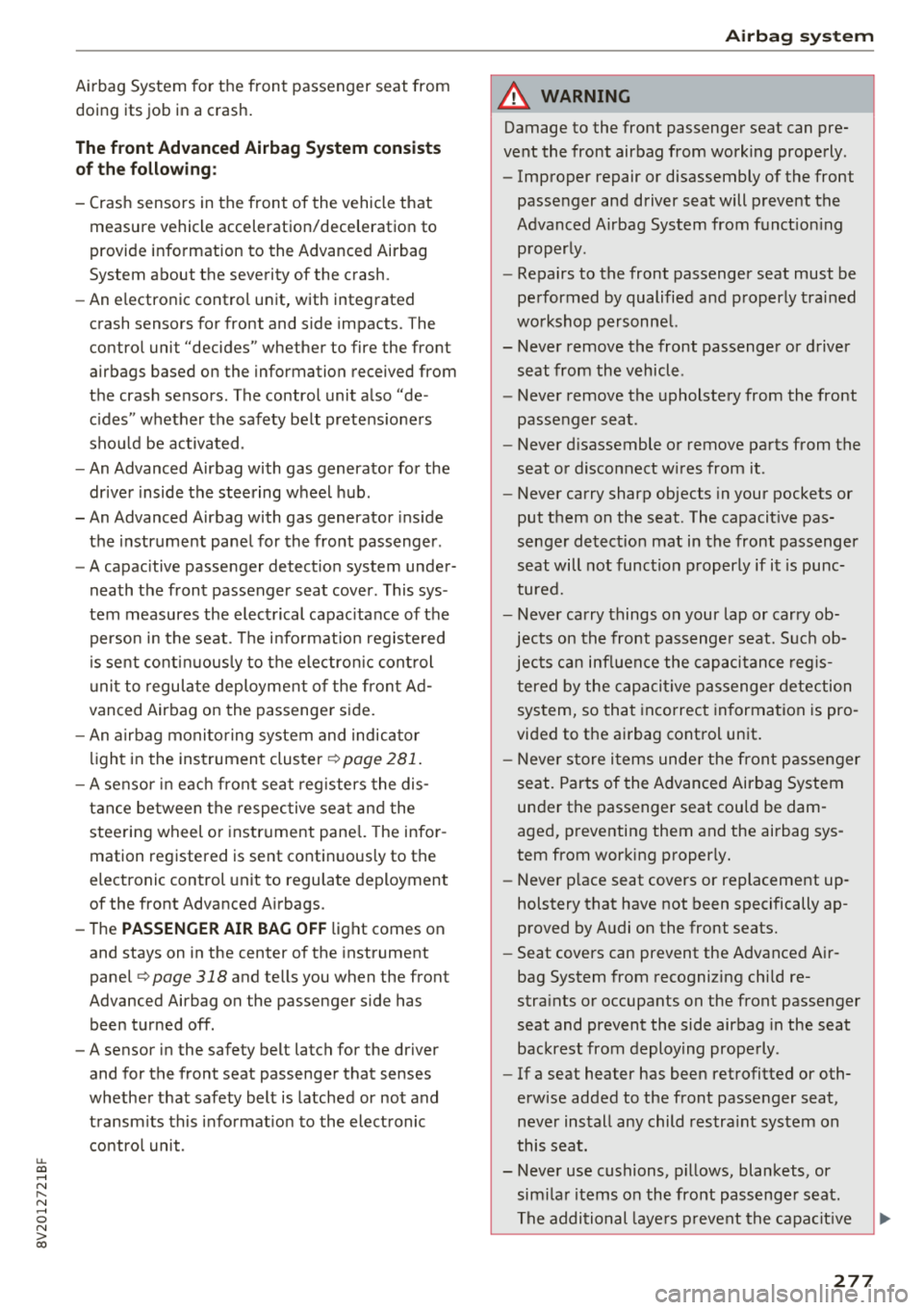
u. 00 .-< N l' N .-< 0 N > 00
Airbag System for the front passenger seat from
doing its job in a crash.
The front Ad vanced Airbag System con sists
o f th e follo wing :
-Cras h sensors in the front of the vehicle that
measure vehicle acceleration/deceleration to
provide information to the Advanced Airbag
System a bout the severity of the crash.
- An electronic control unit, with integrated
crash sensors for front and side impacts. The
contro l unit "decides" whether to fire the front
airbags based on the information received from
the crash sensors . The control unit also "de
c ides" whether the safety belt pretens ioners
shou ld be activated .
-An Advanced Airbag with gas generator for the
dr iver inside the steering wheel hub.
-An Advanced Airbag with gas generator ins ide
the instrument panel for the front passenger.
-A capac itive passenger detect io n system under
neath the front passenger seat cover. This sys
tem measures the elect rical capac ita nce of the
person in the seat. The info rmat ion registe red
is sent cont inuous ly to the electro nic cont rol
u nit to regula te deployment of t he front Ad
vanced Airbag on the passenge r side.
-An a irbag monito ring system and indica tor
li gh t in the ins trument
cluste r¢ page 281 .
-A se nso r in each front seat reg isters the dis
tance between the respec tive sea t and the
steering wheel or instrument pane l. The infor
mation registered is sent continuous ly to the
electronic control unit to regulate deployment
of the front Adv a need A irbags.
-T he PASSENGER AIR BAG OFF light comes on
and stays on in the center of the instrument
panel
¢ page 318 and tells you when the front
Advanced Airbag on the passenger side has been turned off .
-A sensor in the safety belt latch for the driver
and for the front seat passenger that senses
whether that safety belt is latched or not and
transm its this info rmat ion to the elect ronic
contro l unit.
Airbag syste m
.&, WARNING ~ -
Damage to the front passenger seat can pre
vent the front airbag from working properly.
-Improper repair or disassembly of the front
passenger and driver seat will p revent the
Advanced Airbag System from f unct ion ing
p roperly.
-Repairs to the front passenger seat must be
pe rformed by qualified and p roperly trained
wo rkshop personne l.
-Never remove the front passenger or driver
seat from the vehicle .
-Never remove the upholstery from the front
passenger seat.
-Never d isassemble or remove parts from the
seat o r disconnect w ires from it.
-Never carry sharp objects in your pockets or
put them on the seat. The capacit ive pas
senger de tect ion mat in the front passenger
seat will not function p roperly if i t is punc
tured.
-Never carry things on your lap or carry ob
jects on the front passenge r seat. S uch ob
jects can influence the capacitance reg is
tered by the cap aci tive passenger detection
sys tem, so that incorrect in formation is pro
vided to the ai rbag control unit.
-Never store i tems unde r the front passenger
seat . Parts of the Advanced Airbag System
under the passenger seat could be dam
aged, p reventing them and the airbag sys
tem from wor king p roper ly.
-Never p lace seat covers or replacement up
holstery that have not been specifically ap
proved by Audi on the front seats.
-Seat covers can prevent the Advanced Air bag System from recognizing chi ld re
stra ints or occupants on the front passenger
seat and prevent the side airbag in the seat
backrest from deploying properly.
-If a seat heater has been retrofitted or oth
erwise added to the front passenger seat,
never ins tall any child restra int system on
this seat.
-Never use cushions, p illows , blankets, or
similar items on the front passenge r seat .
T he addi tional laye rs prevent the capacit ive
277
Page 280 of 404
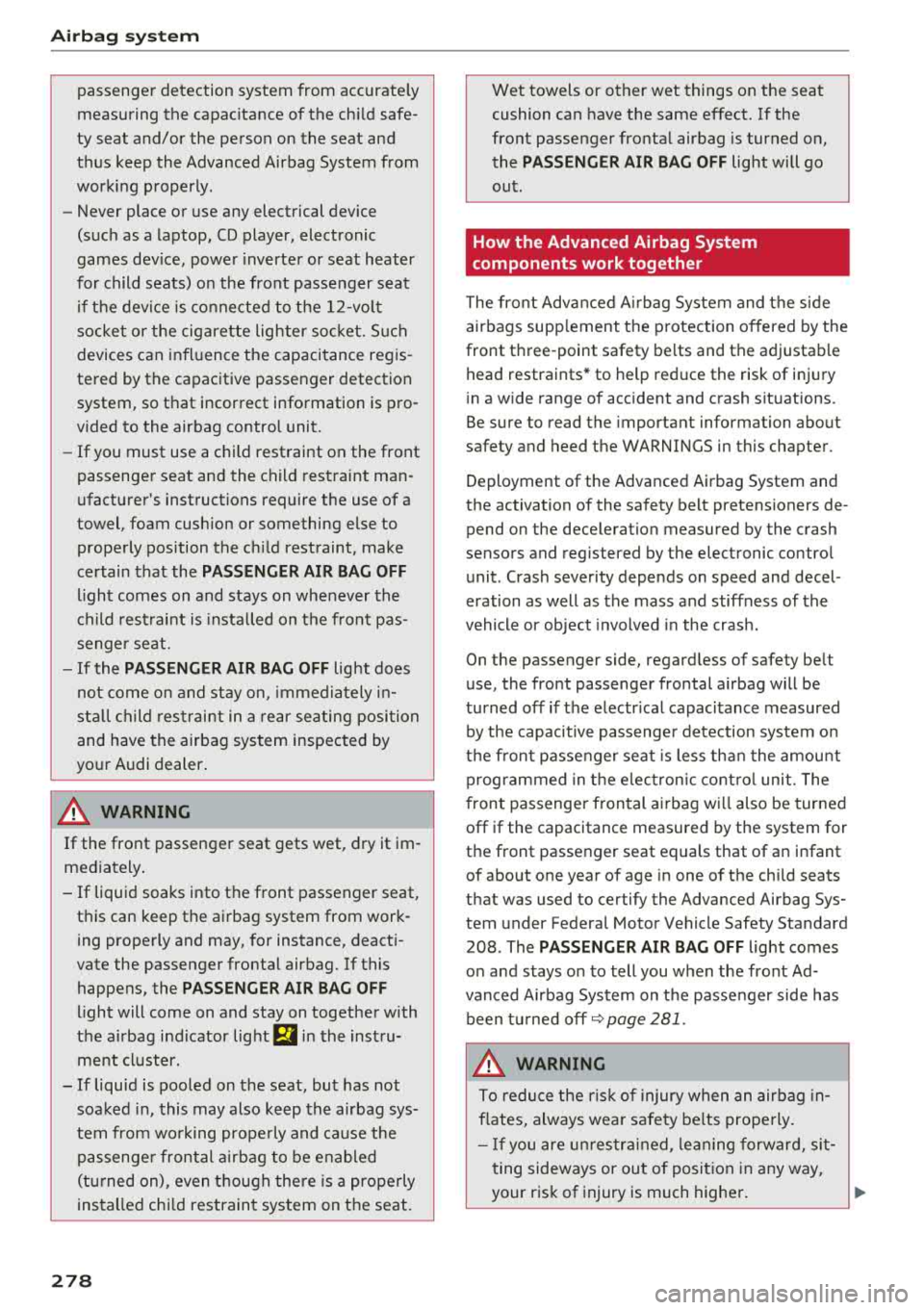
Airbag syste m
passenger detection system from accurately
measuring the capac itance of the ch ild safe
ty seat and/or the person on the seat and
thus keep the Advanced Airbag System from
working properly .
- Never place or use any electrical device
(such as a laptop, CD player, electronic
games dev ice, power inverter or seat heater
for child seats) on the front passenger seat
if the device is connected to the 12-volt
socket or the cigarette lighter socket. S uch
devices can infl uence the capacitance reg is
tered by the capacitive passenger detection system, so that incorrect information is pro
vided to the airbag control unit.
- If you must use a child restraint on the front
passenger seat and the child restraint man
ufacturer 's instructions require the use of a
towel, foam cushion or something else to
properly position the ch ild restraint, make
certain that the
PASSENGER AIR BAG OFF
l ight comes on and stays on whenever the
child restraint is installed on the front pas
senger se at.
- If the PASSENGER AIR BAG OFF light does
not come on and stay on, immedia tely in
st al l child res traint in a rear seating posi tion
and have the airbag system inspected by
yo ur Audi dealer.
A WARNING
If the front passenger seat gets wet, dry it im
mediately .
- If liquid soaks into the front passenger seat,
this can keep the airbag system from work
ing properly and may, for instance, deact i
vate the passenger frontal airbag. If this
happens, the
PASSENGER AIR BAG OFF
light will come on and stay on together with
the a irbag indicator light
m in the instru
ment cluster.
- If liquid is poo led on the seat, but has not
soa ked in, this may also keep the airbag sys
tem from wo rking properly and ca use the
passenge r frontal a irb ag to be enabled
(tu rned on), even though there is a properly
installed chi ld restraint system on the seat.
278
Wet towels or other wet things on the seat
cushion can have the same effect. If the
front passenger fronta l airbag is turned on,
the
PASSENGER AIR BAG OFF light will go
out .
How the Advanced Airbag System
components work together
The fro nt Advanced A irbag System and t he side
airbags supp lement t he protection offered by the
front t hree-point safety be lts and the adjustable
head restraints* to help red uce the risk of inj ury
i n a wide range of accident and crash sit uations.
Be sure to read the important information about
safety and heed the WARNINGS in this chapter.
Deployment of the Advanced Airbag System and
the activation of the safety belt pretensioners de
pend on the dece leration measured by the crash
sensors and registered by the electronic contro l
unit . Crash severity depends on speed and decel
e ration as well as the mass and stiffness of the
vehicle or object involved in the crash.
On the passenger side, regardless of safety belt
use, the front passenger frontal a irbag will be
turned off if the electr ica l capacitance measured
by the capacitive passenge r detection system o n
t h e front passenger seat is less tha n the amount
prog rammed in t he elec tron ic cont ro l unit . The
front passenger frontal a irbag w ill also be turned
off if the capacitance measured by the system for
the front passenger seat equals that of an infant
of about one year of age in one of the chi ld seats
that was used to certify the Advanced Airbag Sys
tem under Federa l Motor Vehicle Safety Standard
208 . The
PASSENGER AIR BAG OFF light comes
o n and stays on to tell you w hen the front Ad
vanced Airbag Sys tem on t he passenger side has
been t urned
off ~ page 281 .
A WARNING
To reduce the ris k of injury when an airbag in
flates, always wea r safe ty belts p rope rly.
- If you are un res tra ined, le a ning forwar d, si t
ting sideways or out of posi tion in any way,
your ris k of injury is much higher.
Ill>